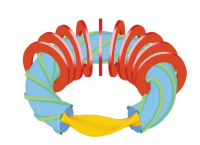








A stellarator is a device used to confine a hot plasma with magnetic fields in order to sustain a controlled nuclear fusion reaction. It is one of the earliest controlled fusion devices, first invented by Lyman Spitzer in 1950 and built the next year at what later became the Princeton Plasma Physics Laboratory. The name refers to the possibility of harnessing the power source of the sun, a stellar object.
Stellarators were popular in the 1950s and 60s, but the much better results from tokamak designs led to them falling from favor in the 1970s. More recently, in the 1990s, problems with the tokamak concept have led to renewed interest in the stellarator design,and a number of new devices have been built. Some important modern stellarator experiments are Wendelstein 7-X, in Germany, the Helically Symmetric Experiment (HSX) in USA and the Large Helical Device, in Japan.
Main goal
The goal of magnetic confinement devices is to transport energy slowly across a magnetic field. Toroidal devices are relatively successful because the magnetic properties seen by the particles are averaged as they travel around the torus. The strength of the field seen by a particle, however, generally varies, so that some particles will be trapped by the mirror effect. These particles will not be able to average the magnetic properties so effectively, which will result in increased energy transport. In most stellarators, these changes in field strength are greater than in tokamaks, which is a major reason that transport in stellarators tends to be higher than in tokamaks.
University of Wisconsin electrical engineering Professor David Anderson and research assistant John Canik proved in 2007 that the Helically Symmetric eXperiment (HSX) can overcome this major barrier in plasma research. The HSX is the first stellarator to use a quasi-symmetric magnetic field. The team designed and built the HSX with the prediction that quasisymmetry would reduce transport. As the team's latest research shows, that is exactly what it does. "This is the first demonstration that quasisymmetry works, and you can actually measure the reduction in transport that you get," says Canik.